- Can a Window Air Conditioner Be Recharged?
- How To Top Off or Add Refrigerant to a Window AC Unit
- Tools and Items Needed to Recharge a Window AC unit
- How To Recharge a Window Air Conditioner
- How To Add a Bullet Schrader Valve
- Window Air Conditioner Refrigerant Type
- Window Air Conditioner Refrigerant Pressure
- Recharging a Window AC Unit Tips
If you have a window air conditioner unit that is not working properly anymore, it may only need a refrigerant charge to get it working again.
Recharging the refrigerant in a window air conditioner is not done often, with most people buying a new unit when an old unit fails.
However, window air conditioners can be recharged with refrigerant and can be put back to work cooling a room or space.
Can a Window Air Conditioner Be Recharged?
Yes, like any HVAC unit, a window air conditioner can be recharged.
The correct refrigerant will be needed along with HVAC gauges.
The steps to recharge a window air conditioner unit are the same as any HVAC unit by adding in the correct amount of refrigerant.
Recharging a unit is not difficult, but if you have never worked with HVAC refrigerants, be sure to study the basics.
How To Top Off or Add Refrigerant to a Window AC Unit (Unofficial Method)
- Official Method: Empty the system and add refrigerant in by weight.
- Unofficial Method: Add refrigerant slowly until the unit starts to cool.
Since many window air conditioners have variable speed compressors adding in or topping off a unit can be difficult to get correct.
Small AC units with variable speed compressors can make using HVAC temperature charts unreliable.
For this reason, the official method to refill a unit is to drain the system and add in the correct amount of refrigerant by weight.
With that said, small amounts of refrigerant can be added to a system in small increments until the unit starts to cool.
While this is not the official way, it can work when done correctly.
The main thing to remember is if too much refrigerant is added to the unit will not work, so only add in small amounts in increments, in 5-7 minute intervals.
Another thing is the correct refrigerant will be needed since mixing refrigerants will have an unknown outcome and likely will not work.
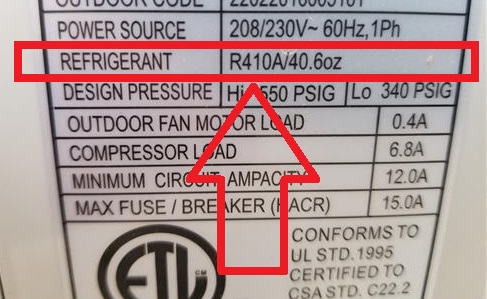
Look at the name tag of the unit and it will display which refrigerant the system uses.
EBay has stopped allowing the sales of many refrigerants such as R410a, but there are many websites which will sell it.
Officially, an EPA 608 card is needed to use HVAC refrigerants, but they can be sold as long as it is for resale.
Many websites get around the EPA 608 card requirement by having the buyer sign a document saying it is for resale.
Also, most small AC units do not have a service port to connect gauges which is easy to fix by adding a low cost bullet valve.
Items Needed to Add Refrigerant to a Window AC Unit
- Bullet Valve (Schrader Valve)
- Recharge Hose or HVAC Gauges
- Correct Refrigerant Type
Example Bullet Piercing Valve on Amazon
Supco BPV21 Bullet Piercing Valve
Example Recharge hose and Bullet Valve Kit on Amazon
Aupoko A/C R134A Refrigerant Charging Hose Kit, Recharge Hose with Gauge, R13A Can Tap and Quick Couple, R410A Straight Swivel Adapter, Piercing Tap Valve Kits, 2PC 1/4’’ Adapters with Valve Core
Steps To Top Off or Add Refrigerant to a Window AC Unit (Unofficial Method)
- Attach a Bullet Schrader valve to the low-pressure line (Big Line).
- Connect the gauge blue low-pressure hose to the Schrader valve.
- Connect the gauge hose to the refrigerant bottle.
- Turn on the window air conditioner and let it run in cool mode.
- Turn the refrigerant valve on for 1-2 seconds and then off, to let in refrigerant.
- Let the unit run for roughly 4-5 minutes and see if it is cooling.
- If the unit is not cooling add in a small amount again and see if it starts to cool.
- Once the unit is cooling stop adding refrigerant and disconnect the hose.
- When the hose is removed refrigerant will come out, simply remove it as quickly as possible.
Tools and Items Needed to Recharge a Window Air Conditioner
- Bullet Valve (Schrader Valve)
- Correct Refrigerant Type
- Recharge Hose or HVAC Gauges
- Weight Scale
- Vacuum Pump
The main tools needed to charge a window air conditioner are a bullet valve, refrigerant, weight scale, and HVAC Gauges.
How To Recharge a Window Air Conditioner (Official Method)
- Attach a Bullet Schrader valve to the low-pressure line.
- Connect the HVAC gauge blue low-pressure line to the Schrader valve on the window AC unit.
- Attach the HVAC gauge yellow center hose to the vacuum pump.
- Turn on the vacuum pump, open the HVAC gauge blue gauge, and set the system into a negative pressure.
- Let the pump run for 15-20 minutes, then turn it off and let the unit sit for 10-20 minutes, and be sure it holds the negative pressure.
- Connect the gauges center yellow hose to the refrigerant tank.
- Turn the refrigerant tank valve on.
- Flip the box of refrigerant upside down so the liquid will flow into the unit instead of vapor.
- Place the refrigerant on the weight scale.
- The HVAC gauge blue low-pressure line should be connected to the Schrader valve on the window AC unit.
- Turn the HVAC blue gauge valve on slowly and let the correct amount of refrigerant in by weight.
- Once the correct amount has gone into the system, turn off the HVAC gauge blue valve.
- Turn the valve off on the refrigerant tank.
- With the refrigerant tank valve off, turn the HVAC blue gauge valve back on to let the unit pull in any refrigerant in the line.
- As quickly as possible, remove the line to the window unit (A small amount of refrigerant will come out; simply go as quickly as possible).
How To Add a Bullet Schrader Valve
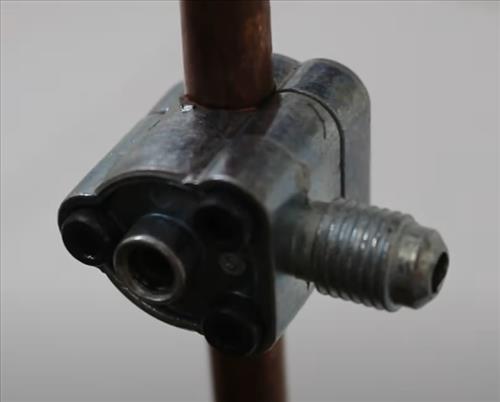
A bullet valve is a quick and easy way to add a recharging port to an AC unit.
Window air conditioners do not usually have a service port that is easily fixed with a low-cost bullet valve.
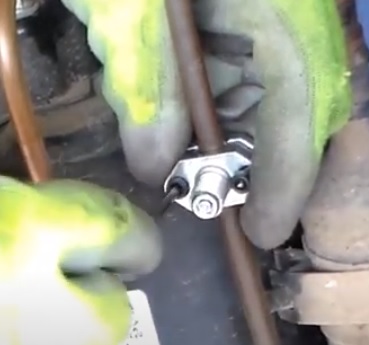
A bullet valve is simple to attach by using an Allen wrench to tighten the screws on it, which has a piercing valve that goes into the line.
It is usually attached to the refrigerant low-pressure line (big copper line).
Read Here for detailed Instructions on Installing a Service Port on a Window A/C unit.
Window Air Conditioner Refrigerant Type

The type of refrigerant the system uses should be labeled on the outside of the unit.
Many old units will use R22, which is not manufactured anymore, and newer units usually use R410a.
There are many online videos and forums of people using R134a refrigerants to recharge window A/C units.
When adding refrigerants, they should never be mixed since the system was not designed for this and will not work correctly.
Also, the oils used in HVAC systems can vary and damage the compressor or other parts.
Many people online and on YouTube claim to have good success using R134a refrigerant in R22 and R410a systems which I wouldn’t recommend.
The reason they are using R134a is it is widely used in vehicle A/C systems with low-cost cans sold online and auto parts stores.
The refrigerant that was designed for the system should be added with no mixing of refrigerant.
Window Air Conditioner Refrigerant Pressure
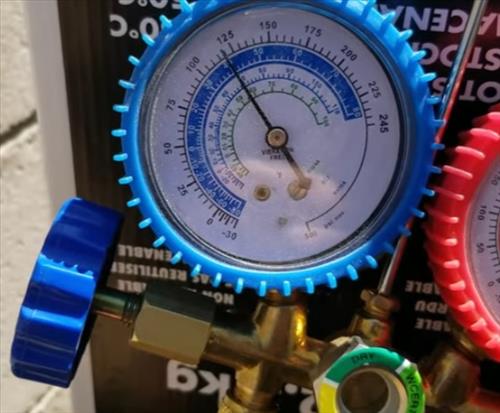
Each HVAC system will have different pressures, which will change depending on the outside temperature.
Many new window A/C units have variable speed compressors, which can make it difficult to match to a temperature pressure chart.
This means each window A/C unit will need the correct pressure or it will not cool.
If a unit is low on refrigerant, the pressure will be lower, and the system will not work.
If a unit is overfilled, the pressure will be too high, and the system will not work.
For this reason, it is necessary to get the pressure correct when adding refrigerant so as not to overfill the system.
I would not go above 35-40 PSI on the low-pressure line before testing the unit and seeing if it starts cooling.
Starting at a lower pressure such as 30 PSI is best, and testing the unit for cooling.
If the unit is not cooling, slowly raise the pressure until it does start cooling.
HVAC gauges or a recharge hose with a pressure gauge, and a temperature pressure chart, will be needed to get the correct pressure.
Recharging a Window Air Conditioner Unit Tips
- Find and Fix Any Leak
- Install a Service Port (Schrader Valve)
- Recharge the Unit
The first step is to check for leaks. If a unit has a very slow leak over the course of a year or more, it will only need a boost.
A fast leak will need to be fixed and repaired before refilling it.
There are a few methods for finding a leak, from a visual inspection to filling a unit with Nitrogen and using soap to find the leak.
Refrigerant leak detectors can also be bought, which sniff out a refrigerant leak and will make a fast audible beep as it moves closer to it.
It is common for leaks to occur at joints which often require soldering them together again.
Small air conditioner units will not usually have a service port to hook up gauges.
Installing a service port is an easy task and requires soldering in a port or using a piercing valve kit.
A piercing valve is easy to install and the most common method to get a Schrader Valve on a unit.
Service ports are usually installed on the low-pressure line to add refrigerant, which is the larger diameter line.
After any leak is fixed and a service port has been installed, the unit is ready for the refrigerant.
HVAC gauges and the correct refrigerant is needed.
Most units today will use R410a but be sure to read the service tag on the unit to be sure.
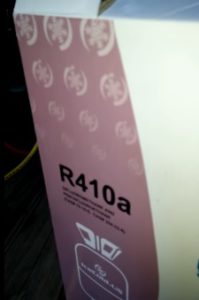
R410a can be bought at air conditioning supply stores or even online.
Hook up your gauges to the service port and the refrigerant tank.
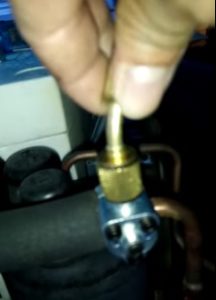
Be sure to know what the PSI should be at before starting. Do not overfill the unit.
Also, be sure to watch your pressures on the gauges along with a temperature pressure chart to know what it should be.
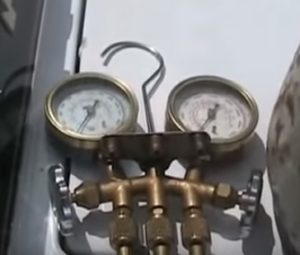
Summary
The above are the basic steps involved in recharging a window air conditioning unit.
Keep in mind there will always be design differences between manufacturers.
Before the refrigerant can be added, a Schrader valve will need to be attached to the low-pressure line.
After attaching the valve, a gauge can be attached, and refrigerant is let into the system.
Be sure to keep in mind the pressure, as too much refrigerant will cause too much pressure, and the unit will not work correctly.
Too much refrigerant can be just as bad as too little refrigerant.
Also, be sure always to follow safety procedures as you would with any HVAC unit.
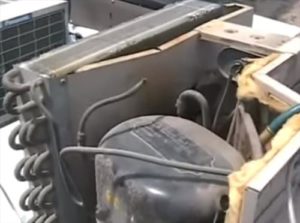
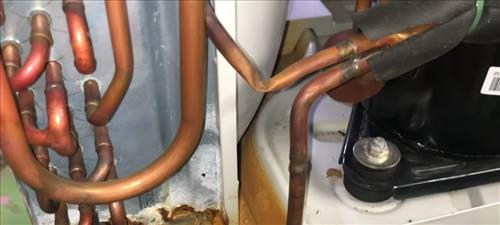
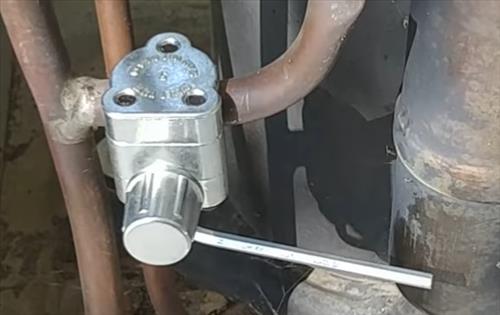
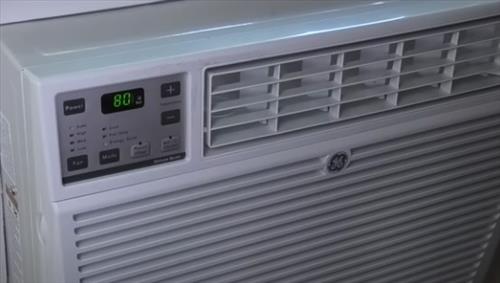
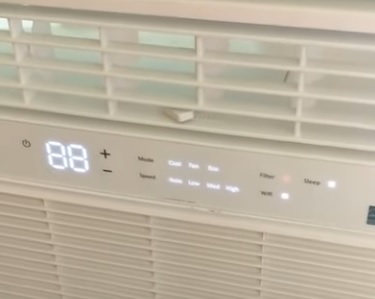
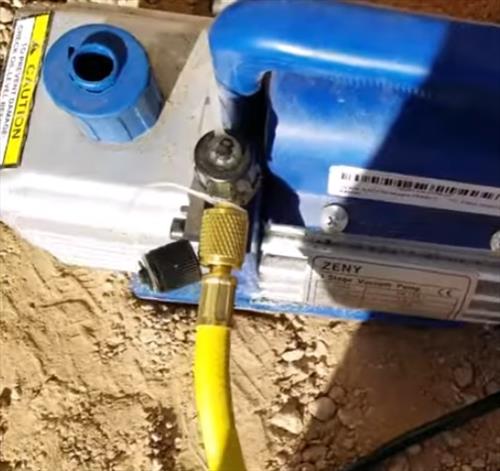
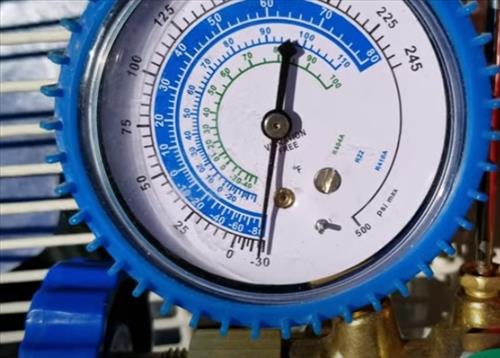
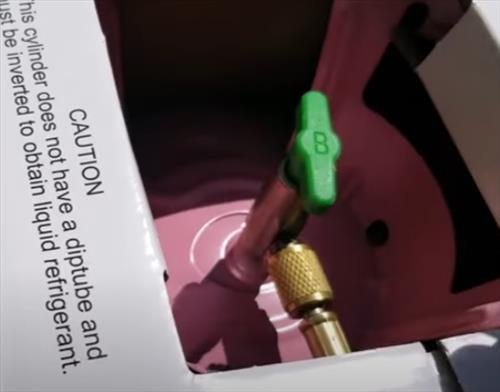
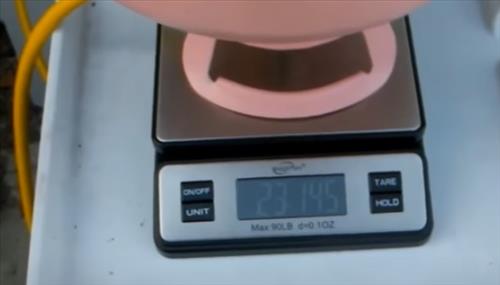
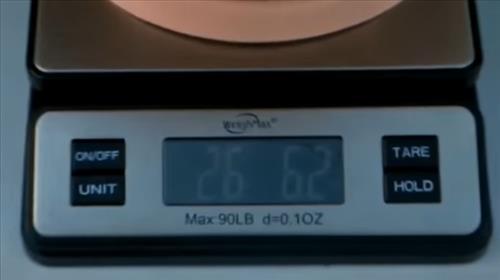
Explanation of charging window air conditioner with Schrader bullet valve installed, while filling system with 410A after pulling negative vacuum pump down do you recharge with the air conditioning system running or off? And I’ve read 410a has to be done as a liquid recharge not a vapor? Do you need to purge air out after pump down and connecting yellow line to Schrader valve installed on low pressure side?
410A is a blend, No? If you lose a partial charge, the blend now is unbalanced and might no work correctly. I was told you have to evac an d put fresh charge in.
I just get them off the trash when people set them out. Then remove the covers to smash the lines. Hell with the fictitious “Ozone Hole” lie. Cool watching that gas and oil blow all over.
I have a question for you I have a GE unit blows great cold air after about 10 minutes all of a sudden it stops blowing and the green mode light starts flashing you let it set about 5 minutes or so green light goes solid and starts like nothing wrong but keeps cycling back and forth. What is causing it to shut off and that annoying light is telling me?
2008 Frederick window unit 2 4 000 BTU icing up on the front where filter goes 4 inches up I was told it was dirty and needed cleaning I had it professionally clean now I’m told it’s icing up because it’s low on freon it’s still blows cold it takes R22 I got on Amazon got a can Proseal22 & 16oz can R22. Low side line on AC PUT IN gas or liquid I don’t know any info would be appreciated
Jim
Very VERY informative article and nice.
If a window unit needs refrigerant recharge it is because of damage, likely corrosion in the evaporator, or cracked tubes from vibration. Not like a car with a normally leaky shaft seal. How long has it been in use?
Get rid of the unit and buy a new one with a warranty. Don’t throw good money after bad.
I appreciate that help on educating us on the windows units. I have a large Fedders air conditioner which I am sure don’t need recharging and wasn’t used that much since purchasing it new. One day I got ready to turn it on after it had been idle all Winter the unit was not blowing air like it did previously. I assume the fan is not blowing either because the blower is not turning. I thank you for the information and I hope to be getting one of the four units working again. I am sure two of them, and maybe three are out of coolant.
Great information about how to recharge a window AC unit. How to Find the leak and fixing it plus the pierce adapter all great information for the DIY types. I’ll get a certified refrigeration technician on the task based on the expertise required.
As a 10 year res install tech myself I appreciate the thorough direct and no bs explanation. Extremely well put and am saving this to show to my helpers
My Tosot window A/C was charged with R32 and has leaked. I think I identified the leak and am ready to recharge. I cant find R32 in a convenient size like the automotive cans. 410 has been removed from shelves with Red Tek 12A and 22A being my only options. Does it matter what one I use? If the compressor craps out, I don’t really care. The unit was cheap, so cheap, it died 1 week after the warranty expired. Just curious what precautions if any, I should take and would 12A or 22A be the better to use?
Thanks for your excellent explanation on servicing window AC’s. I appreciated how you got right to the meat of information, and stayed on-point with each topic you covered. I can’t wait to yank out my 5 year-old Panasonic through-wall unit and regain its lost cooling ability.
Most small AC units have a removable air filter near the front. Remove it and clean it according to your User’s Manual. Try running the AC while you have the filter out for a few minutes to see if it starts blowing cooler air. That might have been your problem.